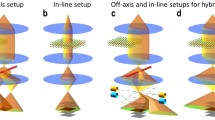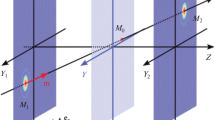Abstract
This paper presents the results of an evaluation of image defects caused by transducer and object position and motion errors in generating an acoustical hologram. The image parameters we studied were lateral and longitudinal resolution. An error analysis, assuming slowly varying gaussian statistics, was used to estimate the mean and standard deviation. The results show that two types of errors must be considered; i.e., position errors may approach an appreciable fraction of the hologram resolution limits; however, motion errors (especially longitudinal motion) are more restrictive and appear to be limited by coherence between object and reference signals. Daubin1 has previously noted longitudinal motion restrictions.
A limited experimental program was followed to validate the theoretical conclusions. The procedure used was to increment transducer and object errors as the hologram was generated. We found that the theoretical predictions were borne out, at least on a subjective basis. Incremental longitudinal position errors as large as 75 wavelengths caused little visible image defects while longitudinal motion errors of one-half wavelength per scan line completely destroyed the image.
Access this chapter
Tax calculation will be finalised at checkout
Purchases are for personal use only
Preview
Unable to display preview. Download preview PDF.
Similar content being viewed by others
References
S. C. Daubin, “System Requirements for Underwater Holographic Mapping”, IEEE Trans. GeoSci. Electron Vol. GE-8, Oct., 1970, pp. 313–320.
B. P. Hildebrand and K. Haines, “Holography by Scanning” Journal of the Optical Society of America, Vol. 59, 1969, pp. 1–6.
B. P. Hildebrand and B. B. Brenden, “Introduction to Acoustical Holography”, BNWL-SA-3467, Battelle, Richland, Washington, 1971 (book in press).
Carl Bennett and Norman Franklin, “Statistical Analysis in Chemistry and the Chemical Industry”, Second Ed., New York, Wiley, 1960, p. 724.
K. A. Brownlee, “Statistical Theory and Methodology”, Second Ed., New York, Wiley, 1960, p. 590.
Author information
Authors and Affiliations
Editor information
Editors and Affiliations
Rights and permissions
Copyright information
© 1972 Plenum Press, New York
About this paper
Cite this paper
Collins, H.D., Hildebrand, B.P. (1972). The Effects of Scanning Position and Motion Errors on Hologram Resolution. In: Wade, G. (eds) Acoustical Holography. Springer, Boston, MA. https://doi.org/10.1007/978-1-4615-8213-7_26
Download citation
DOI: https://doi.org/10.1007/978-1-4615-8213-7_26
Publisher Name: Springer, Boston, MA
Print ISBN: 978-1-4615-8215-1
Online ISBN: 978-1-4615-8213-7
eBook Packages: Springer Book Archive




